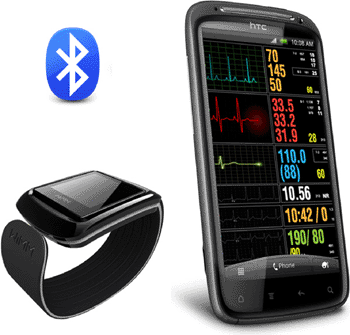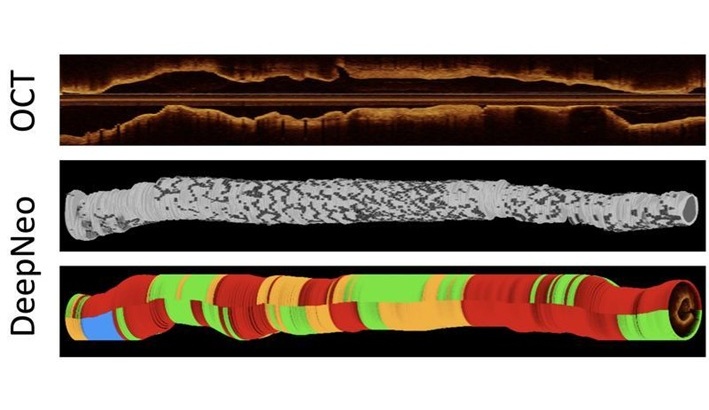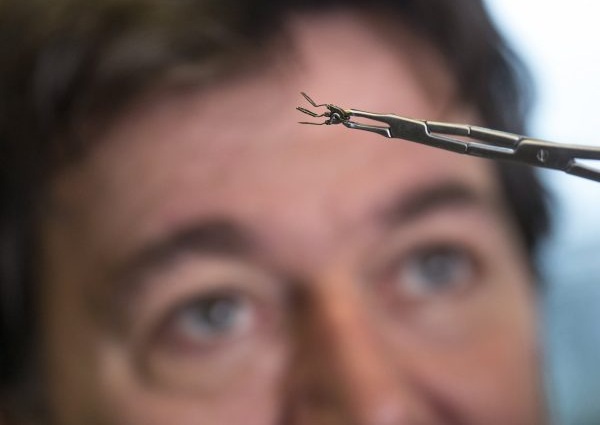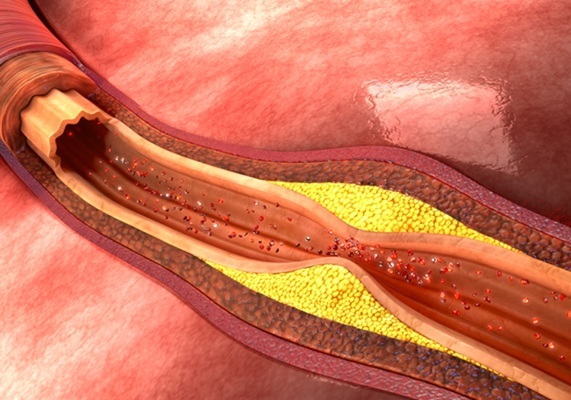Smartphone Technology Meets Personalized Medicine
|
By HospiMedica International staff writers Posted on 14 Mar 2012 |

Image: The CardioDefender Diagnostic System (Photo courtesy of Everist Genomics).
An innovative smartphone electrocardiogram (ECG) system provides physicians and patients with hospital-quality heart rhythm monitoring outside of the hospital setting.
The CardioDefender Diagnostic System delivers mobile heart monitoring and automated reporting by combining patented analytical smartphone software with a Bluetooth device and electrodes, enabling the smartphone to perform as a mobile ECG. Among the features of the system are real-time, heart-rhythm monitoring, with beat-by-beat analysis; long term monitoring for up to three months of real-time, beat-by-beat quantitative patient monitoring; and a comprehensive range of heart rhythm monitoring algorithms that enable automated detection and reporting of medically important symptomatic and asymptomatic arrhythmias.
The abnormal heart rhythms are reported directly to the physician, using innovative software and data compression technology to report real-time results to a smartphone, tablets, laptop, or desktop computer, in addition to a cardiac monitoring center. Access is available on demand to full, detailed ECG data captured during the monitoring period, including post heart monitoring data processing for additional measurements. The CardioDefender Diagnostic System is a product of Everist Genomics (Ann Arbor, MI, USA), and has been approved by the US Food and Drug Administration (FDA).
“Physicians who diagnose and treat heart arrhythmias have been hampered for many years by legacy technology, such as hospital based ECG systems which confine patients to the high-cost hospital setting and Holter monitors which do not provide the comprehensive monitoring needed to detect potentially life threatening arrhythmias,” said Alex Charlton, executive vice chairman of Everist Genomics. “For the first time, CardioDefender enables smartphone-based hospital-quality ECG monitoring of patients 24 hours per day, seven days per week.”
In addition to the CardioDefender diagnostic system, the company has recently announced the development of the AngioDefender, a tablet computer device capable of accurately diagnosing atherosclerosis in asymptomatic patients.
Related Links:
Everist Genomics
The CardioDefender Diagnostic System delivers mobile heart monitoring and automated reporting by combining patented analytical smartphone software with a Bluetooth device and electrodes, enabling the smartphone to perform as a mobile ECG. Among the features of the system are real-time, heart-rhythm monitoring, with beat-by-beat analysis; long term monitoring for up to three months of real-time, beat-by-beat quantitative patient monitoring; and a comprehensive range of heart rhythm monitoring algorithms that enable automated detection and reporting of medically important symptomatic and asymptomatic arrhythmias.
The abnormal heart rhythms are reported directly to the physician, using innovative software and data compression technology to report real-time results to a smartphone, tablets, laptop, or desktop computer, in addition to a cardiac monitoring center. Access is available on demand to full, detailed ECG data captured during the monitoring period, including post heart monitoring data processing for additional measurements. The CardioDefender Diagnostic System is a product of Everist Genomics (Ann Arbor, MI, USA), and has been approved by the US Food and Drug Administration (FDA).
“Physicians who diagnose and treat heart arrhythmias have been hampered for many years by legacy technology, such as hospital based ECG systems which confine patients to the high-cost hospital setting and Holter monitors which do not provide the comprehensive monitoring needed to detect potentially life threatening arrhythmias,” said Alex Charlton, executive vice chairman of Everist Genomics. “For the first time, CardioDefender enables smartphone-based hospital-quality ECG monitoring of patients 24 hours per day, seven days per week.”
In addition to the CardioDefender diagnostic system, the company has recently announced the development of the AngioDefender, a tablet computer device capable of accurately diagnosing atherosclerosis in asymptomatic patients.
Related Links:
Everist Genomics
Latest Health IT News
- Printable Molecule-Selective Nanoparticles Enable Mass Production of Wearable Biosensors
- Smartwatches Could Detect Congestive Heart Failure
- Versatile Smart Patch Combines Health Monitoring and Drug Delivery
- Machine Learning Model Improves Mortality Risk Prediction for Cardiac Surgery Patients
- Strategic Collaboration to Develop and Integrate Generative AI into Healthcare
- AI-Enabled Operating Rooms Solution Helps Hospitals Maximize Utilization and Unlock Capacity
- AI Predicts Pancreatic Cancer Three Years before Diagnosis from Patients’ Medical Records
- First Fully Autonomous Generative AI Personalized Medical Authorizations System Reduces Care Delay
- Electronic Health Records May Be Key to Improving Patient Care, Study Finds
- AI Trained for Specific Vocal Biomarkers Could Accurately Predict Coronary Artery Disease
Channels
Critical Care
view channel
AI Model Analyzes Patient Data to Diagnose Multiple Sclerosis With 90% Accuracy
Multiple sclerosis (MS) is a chronic inflammatory condition affecting the central nervous system. Most patients initially experience the relapsing-remitting form (RRMS), characterized by periods of symptom... Read more
Magnetically Navigable Microparticles Enable Targeted Drug Delivery
Abdominal aortic aneurysms (AAA) can be life-threatening if not treated and result in nearly 10,000 deaths annually. Researchers working to improve treatments for AAA could now make it possible for doctors... Read more
AI-Powered Algorithm Automates Analysis of Coronary Stents After Implantation
Every year, over three million people globally receive stents to open blocked blood vessels caused by heart disease. However, monitoring the healing process after stent implantation remains a significant challenge.... Read moreSurgical Techniques
view channel
DNA Origami Improves Imaging of Dense Pancreatic Tissue for Cancer Detection and Treatment
One of the challenges of fighting pancreatic cancer is finding ways to penetrate the organ’s dense tissue to define the margins between malignant and normal tissue. Now, a new study uses DNA origami structures... Read more
Pioneering Sutureless Coronary Bypass Technology to Eliminate Open-Chest Procedures
In patients with coronary artery disease, certain blood vessels may be narrowed or blocked, requiring a stent or a bypass (also known as diversion) to restore blood flow to the heart. Bypass surgeries... Read more
Intravascular Imaging for Guiding Stent Implantation Ensures Safer Stenting Procedures
Patients diagnosed with coronary artery disease, which is caused by plaque accumulation within the arteries leading to chest pain, shortness of breath, and potential heart attacks, frequently undergo percutaneous... Read more
World's First AI Surgical Guidance Platform Allows Surgeons to Measure Success in Real-Time
Surgeons have always faced challenges in measuring their progress toward surgical goals during procedures. Traditionally, obtaining measurements required stepping out of the sterile environment to perform... Read morePatient Care
view channel
Portable Biosensor Platform to Reduce Hospital-Acquired Infections
Approximately 4 million patients in the European Union acquire healthcare-associated infections (HAIs) or nosocomial infections each year, with around 37,000 deaths directly resulting from these infections,... Read moreFirst-Of-Its-Kind Portable Germicidal Light Technology Disinfects High-Touch Clinical Surfaces in Seconds
Reducing healthcare-acquired infections (HAIs) remains a pressing issue within global healthcare systems. In the United States alone, 1.7 million patients contract HAIs annually, leading to approximately... Read more
Surgical Capacity Optimization Solution Helps Hospitals Boost OR Utilization
An innovative solution has the capability to transform surgical capacity utilization by targeting the root cause of surgical block time inefficiencies. Fujitsu Limited’s (Tokyo, Japan) Surgical Capacity... Read more
Game-Changing Innovation in Surgical Instrument Sterilization Significantly Improves OR Throughput
A groundbreaking innovation enables hospitals to significantly improve instrument processing time and throughput in operating rooms (ORs) and sterile processing departments. Turbett Surgical, Inc.... Read moreBusiness
view channel
Expanded Collaboration to Transform OR Technology Through AI and Automation
The expansion of an existing collaboration between three leading companies aims to develop artificial intelligence (AI)-driven solutions for smart operating rooms with sophisticated monitoring and automation.... Read more














